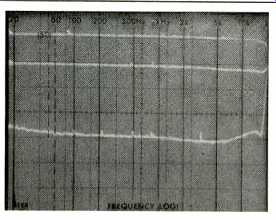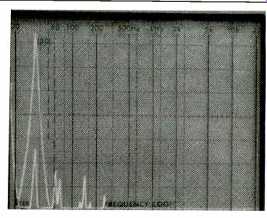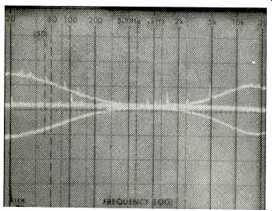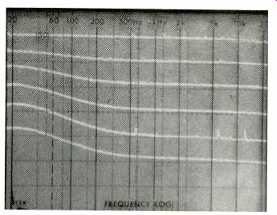
Manufacturer's Specifications
FM Tuner Section:
Usable Sensitivity: Mono, 12.8 dBf.
Quieting Sensitivity: Mono, 15.2 dBf; stereo, 36.8 dBf (per DIN Standard).
S/N Ratio: Mono, 84 dB; stereo, 80 dB.
THD at 1 kHz: Mono, 0.15%; stereo, 0.3%.
Frequency Response: 20 Hz to 15 kHz, +0.3.-0.8 dB.
Capture Ratio: 2.0 dB.
Adjacent-Channel Selectivity: 16 dB.
Alternate-Channel Selectivity: 96 dB.
Image Rejection: 110 dB.
Rejection: 110 dB.
Spurious-Response Rejection: 110 dB.
Subcarrier-Product Rejection: 78 dB.
Stereo Separation at 1 kHz: 43 dB.
Muting Threshold: 18 dBf.
Stereo Threshold: 26 dBf.
Output Level at Tape Out: 1.8 V.
AM Tuner Section Usable Sensitivity: 36 uV
Frequency Response: 120 Hz to 3 kHz,-6 dB.
THD at 1 kHz: 1.5% for 80% modulation.
S/N Ratio at 80% Modulation: 60 dB.
Muting Threshold: 50 uV
Output Level for 80% Modulation: 1.5 V at tape output.
Preamplifier Section:
Frequency Response: 20 Hz to 20 kHz, +0,-0.3 dB.
Phono Equalization: RIAA ±0.3 dB.
THD at 1 kHz: 0.005% for rated out put.
S/N Ratio: MM phono, 80 dB re: 5 mV input; MC phono (optional), 76 dB re: 0.5 mV input; high level, 96 dB re: 500 mV input and rated output.
Channel Separation at 1 kHz:
Phono, 60 dB; high level, 75 dB.
Crosstalk Between Inputs at 1 kHz: 90 dB.
Rated Output Level: Output "A," 6 V; output "B," 2 V; headphones, 6 V; tape. 500 mV.
Input Sensitivity for Rated Output: MM phono, 2.7 mV; MC phono (optional), 0.5 mV; high level, 250 mV.
Maximum Input Level: MM phono, 150 mV; MC phono (optional), 6 mV; high level, 8 V.
Tone-Control Range: Bass, ± 12 dB at 40 Hz; treble, ± 10 dB at 15 kHz.
Subsonic Filter (Phono Only): 12 dB per octave, -3 dB at 15 Hz.
General Specifications Power Requirements: 115 V a.c., 60 Hz; 50 watts maximum.
Environmental Operating Temperature: 40° to 104° F (5° to 40° C).
Dimensions: 17 3/4 in. W x 6 in. H x 13 1/16 in. D (45 cm x 15.3 cm x 33.2 cm).
Weight: 20 lbs. (9 kg).
Prices: $1,690; MC input, $95; B205 remote, $125; B206 Transceiver, $125; B203 timer controller, $500.
Company Address: 1425 Elm Hill Pike, Nashville, Tenn. 37210.
I have long wondered why the combination tuner/preamplifier component is so uncommon. Years ago, in the early days of high-fidelity equipment, many manufacturers offered such units. One reason for the relative rarity of this very practical combination today may be the relative unimportance of FM broadcasting in Japan, where so much of our present-day audio hardware comes from. In fact, receivers, too, are practically never sold in Japan, but there seems to be enough of a demand for them in the U.S. to justify their manufacture by Asian firms for export.
By contrast, in Europe--and specifically in Switzerland and West Germany, where the Studer and Revox divisions of Willi Studer AG are based--FM is as popular as it is in this country. In light of that popularity, the advantages of a high-quality tuner/preamp such as the 8286 become obvious. It can be combined with a power amplifier that delivers exactly the output power you require or it can be used with powered speakers (such as Revox's own Agora Bs.) The Revox B286 tuner/preamp is one of the most versatile and feature-laden units of its kind that I have ever tested. Its dual-microprocessor tuning section lets you program a total of 29 AM and FM stations into its nonvolatile memory.
Optimum reception modes for each station can also be programmed. Furthermore, since not all FM (and certainly not all AM) stations are received at equal volume, it is possible to individually set loudness levels for each of the stations you preset, as well as for all other program sources connected to this remarkable component. Therefore, when you switch between memorized stations or between sources, you won't have to scramble for the volume control.
When used with the B286, the optional 8205 remote control handles such functions as power on/off, source selection, preset-station scanning and recall, NB output selection, volume adjustment, balance, tone defeat, and 20-dB muting. With the addition of the optional 8203 timer controller, the 8205 remote can also operate and program other Revox components connected to the tuner/preamp.
The timer controller also has an RS-232 port for programmed control by a computer. With the further addition of the 8206 remote-control "Transceiver," which relays control commands between rooms, the 8205 can control an entire multi-room system.
Control Layout
At the upper left of the front panel are numbered keys for addressing the 29 possible station memories, a "Tuner/ Enter" key, and a key which is used to sequentially read out the assigned station memories. "Volume" buttons (up and down) are at the center of the panel; farther to the right are the audio-mute, tone-defeat, and program-source selector buttons ("Phono," "Disc," and "Tape 1" and "Tape 2" loops). In the upper right corner is the main "Power" switch which, when used to turn on the tuner/preamp, powers up the unit with the last selected source. However, you can also turn the unit on by pressing the "Phono," "Disc," or "Tuner/ Enter" buttons, which simultaneously selects the indicated input. This is a rare and worthwhile convenience, giving you direct access to any source you like, even when the 8286 is turned off.
The "Tuner/Enter" button has yet another function in addition to source selection and turning on the power. It is also used when recalling preset stations to register the memory number you select.
The lower left section of the panel, aside from the phone jack, is devoted entirety to tuner-related controls. Two "Alpharumeric" buttons permit you to key in the call letters of memorized stations. To do this, you first press the "Display" key, then the preselect button for the station whose call letters you wish to store; next you scan up and down through the alphabet with the "Alphanumeric" buttons.
When you find the first letter you desire, press the "Cursor" button to get into the second letter position, and so on for each position. When you're finished, press "Store" to enter this information into memory. You can store other information, too, such as the type of programming each station favors or you might even enter the name of a disc jockey on each station.
Other buttons at the lower left are used for up/down "Autotuning" (automatic station search), "Frequency Step" tuning, FM muting, mono/stereo and stereo blend selection, and AM/FM selection.
Controls at the lower right of the panel handle all preamplifier-section functions. The "Sensitivity" control allows programming of input sensitivities for the preset stations and other program sources. A control marked "Volume Top" enables you to limit maximum listening volume. Buttons for both tape monitors, subsonic filter (in the phono mode), bass, treble, loudness compensation, channel balance, and selection of outputs are also located in this area. You may select either a high-level output ("A"), low-level ("B"), or neither, for headphone-only listening.
A display area at the center of the panel offers a variety of status indications. Tuner functions shown on the display include station frequency or call letters, the number of the station memory in use, center-tune indication, FM muting status (auto or off), mono/stereo and blend switching, tuner band (AM or FM), and stereo FM reception. Preamp displays include volume level (in dB),-20 dB mute, balance, bass and treble tone-control settings, and the status of the input, output, and tape-monitor selectors, subsonic filter, and loudness compensation.
On the rear panel of the 8286 are jacks for high- and low level output, CD and phono inputs, and two sets of tape record/play jacks. There are also a ground terminal, a serial link terminal for connection to the 8203 timer controller or B206 Transceiver, the antenna connections, and two switches. One of these switches selects any of three phono load capacitances to match whatever moving-magnet cartridge and arm cabling you use. The other, a pushbutton near the phono input jacks, selects moving-magnet or moving-coil operation-but only if you purchase the MC input option.
The FM antenna terminal is a 75-ohm coaxial type, but it uses a European connector rather than the Type F or BNC connectors used in the U.S. Revox therefore supplies a matching male plug for this terminal, as well as a 300/75 ohm step-down transformer. For AM reception, a separately mountable loop antenna is supplied; the antenna terminals also allow an outdoor antenna to be connected for both FM and AM.
FM Tuner Measurements
Mono usable sensitivity for the FM tuner section of the B286 was 12 dBf, slightly better than claimed. In stereo, a signal level of 22 dBf was required to reach "usable-sensitivity" performance. Fifty-dB quieting was reached with a signal level of 14 dBf in mono and 38 dBf in stereo. These levels are not comparable to the manufacturer's "Quieting Sensitivity" spec, since, as a European company, Revox uses the DIN Standard. In any case, the sensitivity of this tuner was very good, regardless of how you define the measurement.

Fig. 1-Mono and stereo quieting and distortion characteristics, FM section.

Fig. 2-THD vs. modulating frequency, FM section.

Fig. 3--Frequency response (top trace) and separation vs. frequency
with blend activated (middle trace) and deactivated (bottom trace). Note
flatness of middle trace (see text).

Fig. 4--Analysis of distortion and crosstalk for 5-kHz FM modulating
frequency. Note lack of spurious crosstalk components and of subcarrier
leakage.
Best signal-to-noise ratio obtained with strong input signals was 87 dB in mono, significantly better than the 84 dB claimed. The S/N in stereo also exceeded the manufacturer's spec, with a measured value of 82 dB. Quieting characteristics, as well as harmonic distortion at 1 kHz, are plotted in Fig. 1 as a function of input signal level. With strong signals applied, THD at this frequency reached a low of 0.12% in mono and was actually a bit lower in stereo, reaching only 0.09%. Both figures are lower than those claimed in Revox's conservative specification sheet.
Test standards require measuring THD at 100 Hz and 6 kHz, as well as 1 kHz. At 100 Hz, THD measured 0.11% in mono and 0.14% in stereo; at 6 kHz, THD was 0.065% in mono and 0.27% in stereo. Figure 2 shows how harmonic distortion varies with frequency for the FM tuner section operated in mono and in stereo.
Rather than have stereo "blend" turn on automatically in the presence of a noisy or weak stereo FM signal, Revox leaves the decision about blending up to the user. Figure 3 shows FM frequency response, full separation, and separation with the blend control turned on. Response was extremely flat from 30 Hz to 15 kHz, with the output down only 0.3 dB at the high-frequency extreme. This is very unusual for an FM tuner. Most tuners, in an attempt to provide a high degree of attenuation at 19 kHz, begin to roll off somewhat short of the 15-kHz cutoff point. Revox was able to maintain virtually flat response all the way out to 15 kHz while at the same time providing more than 75 dB of attenuation (or rejection) of 19- and 38-kHz subcarrier products! On the other hand, SCA rejection was not as good as I might have hoped, measuring only 55 dB. It is quite possible that SCA is not used extensively in Europe, and the designers of this tuner section may not have had much experience with SCA interference problems. Since a majority of FM stations in this country no longer employ an SCA carrier (for secondary programming), the rather poor SCA rejection may not pose a problem in your area or with the stations which you normally listen to. It's a point that should be checked out, though, if you know that your favorite stations transmit SCA programming.
With the blend feature deactivated, separation at mid-frequencies measured 45 dB. At 100 Hz, separation was equally high, and at 10 kHz, it decreased to 36 dB-still more than adequate. With the blend switch turned on, separation was reduced to around 12 dB across the audio band.
Unlike most blend circuits, Revox's reduces separation over the entire audio spectrum almost equally, rather than just at the high-frequency extreme. When I thought about this (and listened to some weak stereo signals), I realized that it makes a lot of sense. After all, background noise in FM is essentially white noise that's already somewhat rolled off at the high end by de-emphasis. Therefore, the noise spectrum contains low and middle frequencies. In some cases, these frequencies may be as great in amplitude as the high-frequency hiss which first comes to mind when you think about FM background noise.
Figure 4 shows what can be done, as far as crosstalk is concerned, in a properly designed tuner. The tall spike at the left represents a 5-kHz signal modulating the left channel at 100%. The shorter spike contained within it shows separation at 5 kHz, and the shorter spikes to the right represent second-, third-, and fourth-harmonic distortion components appearing at the output of the unmodulated channel. The greatest of these (second harmonic) is down some 55 dB relative to 100% modulation. More important, there is not the slightest evidence of any other spurious crosstalk components at the unmodulated channel's output.
There is no subcarrier leakage visible within the dynamic range of this spectrum analyzer display.
Muting threshold measured 17 dBf, very close to the 18 dBf claimed by Revox and an ideal setting. Stereo threshold was actually a bit lower than stated, with the switchover from mono to stereo occurring as signal levels reached 22 dBf.
At this switchover point, signal-to-noise ratio was already close to 40 dB.
Capture ratio measured 1.8 dB, and alternate-channel selectivity measured 95 dB. Spurious-response rejection, i.f. rejection, and image rejection were all in excess of 100 dB.
AM suppression, not specified, was a very high 62 dB.
AM Tuner Measurements
Revox is one of only a few companies to spell out the full performance-for better or worse-of their AM tuner sections. Since they have been so honest about this often overlooked section, I decided to make a few more AM measurements than I usually do. As shown in Fig. 5, frequency response extended to 3.5 kHz for the-6 dB cutoff point. That may not sound like much-until you compare it with the-6 dB point of most other AM tuners, which usually occurs at around 2.0 or 2.5 kHz. In any event, Revox claims response only to 3.0 kHz for this AM section, so they more than meet that claim. Signal-to-noise ratio for the AM tuner, referred to 60% modulation, measured 53 dB, and THD for a 1-kHz signal at 30% modulation was 1.4%. Usable sensitivity was 30 µV, quite a bit better than the 36 ILV claimed. The AM muting threshold was set at 25 uV.
Preamplifier Measurements
The sample B286 that I measured was not equipped with the optional moving-coil inputs. Phono input sensitivity via the built-in moving-magnet cartridge inputs measured 1.7 mV for the standard 0.5 V to be delivered at the low-level preamp output terminals. Since the high-level outputs provide more gain, you will only need 0.55 mV at the phono inputs to produce the same 0.5 V at these outputs. Phono overload, for a 1-kHz input signal, was 200 mV, well above the 150 mV claimed. Phono signal-to-noise ratio measured at the high output terminals was 77 dB; at the low outputs it was almost the same, 78 dB. For these measurements, a standard 5-mV input signal was used and the volume control was adjusted for a standard 0.5-V output.
It was clear from my measurements that Revox has chosen to use a modified RIAA playback curve rather than the original equalization curve specified by the RIAA more than 30 years ago. The IEC (International Electrotechnicalcom mission) supports an equalization characteristic which produces an extra roll-off at the low end, beginning at about 35 Hz and continuing all the way down to 2 Hz; they take the position that this added roll-off reduces the audible effects of turntable rumble. So, when I measured the RIAA equalization accuracy, I found less than 0.2 dB of deviation from 15 kHz down to 50 Hz. At 30 Hz, however, the extra time constant recommended by the IEC (and incorporated in this preamp section) produced a-1.0 dB deviation compared with the original RIAA curve. At 20 Hz, there was an additional roll-off to-2.5 dB. If the subsonic filter is turned on, additional attenuation is introduced which results in a further reduction of subsonic frequency response. At 20 Hz, response is then down 3.0 dB (compared to the unmodified RIAA curve), and at 10 Hz, an additional attenuation of 13 dB occurs.
High-level input sensitivity measured 26 mV for 0.5 V output at the high-level '("A") output jacks and 80 mV for the same output level at the low-level ("B") jacks. Signal-to noise ratio for the high-level inputs measured 89 dB at the "A" outputs and 92 dB at the "B" outputs, for 0.5 V out and a 0.5-V input signal at 1 kHz. Overall frequency response via the high-level inputs extended from 6 Hz to 50 kHz for a-1 dB roll-off and from 3 Hz to 95 kHz for the-3 dB cutoff points. Within the audible range from 20 Hz to 20 kHz, response was flat to within 0.2 dB. Maximum output at the high-level outputs was 10.0 V before significant amounts of harmonic distortion were observed. From the low-level out puts, as much as 3.0 V could be obtained before noticeable distortion occurred. The volume control's two stereo sections tracked each other perfectly (I couldn't even detect 0.1 dB of difference between channels) all the way from maxi mum setting down to the- 80 dB setting.
Figure 6 shows the cut and boost range of the bass and treble controls. Notice that levels of the midrange frequencies, from around 400 Hz up to around 2.5 kHz, are not affected, even when the bass and treble controls are set to their maximum or minimum points. This is how a good set of bass and treble controls should be designed, though all too few are.
I am also in full agreement with Revox's treatment of the loudness compensation. Revox has wisely elected to boost only bass response when the volume control is adjusted for lower and lower listening levels. A careful examination of the well-known Fletcher-Munson "equal loudness" curves will show that, although human hearing does tend to fall off at the high end (i.e., it takes higher levels of high frequencies to be perceived as equal in loudness to middle frequencies), the fall-off does not increase as listening levels are lowered. Therefore, the treble boost added by most loudness-compensation circuits is really not necessary; only the amount of bass compensation needs to be increased as lower and lower listening levels are used. The curves of Fig. 7 show that the Revox engineers understand this psycho acoustic phenomenon and have designed their loudness compensation circuitry accordingly.

Fig. 5--Frequency response, AM section.

Fig. 6--Tone-control range, preamplifier section. Note absence of effect
on midrange.

Fig. 7--Characteristics of loudness compensation. Note that only bass is
affected.
Use and Listening Tests
If you have the room-and can afford it-the 8286 is a precision component worth owning. Revox has never been known for miniaturized products, and this tuner/preamp is no exception. Once you accept its rather bulky size and begin to use its intelligently designed features, you quickly realize, as I did, that its ergonomics are as close to perfection as anyone has yet achieved. Beyond all this, however, it's the excellent sound quality of the B286 which astounded me. Although the distortion figures for the FM tuner section were not the lowest I've ever measured, signals from properly operated FM stereo stations were received with an openness and clarity that has to be heard to be believed.
With a good antenna connected, background noise was so low that I was able to enjoy listening to broadcasts of CDs without having to make excuses for the background noise levels which normally limit the dynamic range of such transmissions.
The controls had a nice, positive tactile feedback, despite the light touch needed to activate them. While the alphanumeric station-designation storage may seem a bit unnecessary to some, it probably didn't account for much of the cost of this product, and it is fun to use and observe.
Years ago, preamplifiers (and, for that matter, tuner/pre amplifiers) had input level controls which served to equalize the levels of all program sources connected to them. Revox's "input sensitivity alignment" feature goes well beyond that, in that it adjusts listening levels for individual stations (some of which modulate more heavily than others) as well as for different external program inputs. If you have ever had to reach for a volume control whenever you switched stations or program sources, you will really appreciate this feature. I suspect that this would be even more important if I were sitting across the room from the set and switching stations or program sources using the optional remote. That remote (which I didn't have when testing the B286) does have a volume control, but it probably responds slower than built-in volume controls, since those on remotes usually do.
Certainly not everyone is prepared to spend well over $1,000 for a tuner/preamp, but the price is not really that out of line when you consider that a separate tuner would have to be augmented by either a separate preamplifier/control component or an integrated amplifier. With the B286, all you need is a power amp or, as mentioned earlier, an active speaker system which includes its own power amplifier. And make no mistake about it. Just because the preamplifier is an integral part of the 8286, don't think that it could not stack up against any separate, high-quality preamp. In many ways, the preamplifier performance of this two-for-one unit surpasses that of some of the best high-priced, high performance preamplifiers I have measured and listened to.
For example, if you've generally been against the use of tone controls because they tend to color critical mid-frequency response, you'll quickly change your mind when you begin to use the bass and treble circuits of the B286. I found myself able to compensate for source material which I felt lacked upper treble or which was recorded with an exaggerated amount of lower bass. I was able to do this without using an expensive graphic equalizer and without having to tolerate obvious imbalances in the tonal structure of the music itself.
Anyone who has ever dealt with a Revox tape deck knows the true meaning of the phrase "Swiss craftsmanship." Now that same phrase applies to the Revox B286. It has the unmistakable touch of excellence that I've come to expect from Dr. Willi Studer and his crew of perfectionists.
-Leonard Feldman
(Source: Audio magazine, Dec. 1986)
Also see:
Revox B260 FM Tuner (Sept 1988)
Revox B215 Cassette Deck (July 1985)
Rockford Fosgate RF200 Preamp and RF2000 (Jun. 1990)
RG Dynamics Model RG D-3 Stereo Preamplifier (May 1980)
= = = =